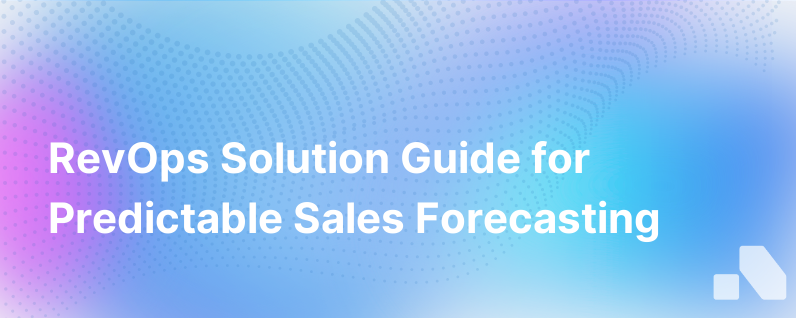
Predictable sales forecasting is the linchpin of any growth-driven organization. It's not simply about estimating future sales but creating a robust framework that provides consistent, reliable results. This is where Revenue Operations (RevOps) solutions come in, offering a transformative strength to any sales strategy with their technological prowess and data-driven insights.
Predictability in forecasting translates to a more strategic allocation of resources, better decision making, and a clear path to scaling revenue. But the selection of an ideal RevOps solution that aligns with your organization's needs requires thorough consideration. The market boasts a plethora of tools, each promising to revolutionize forecasting — yet not all are created equal.
Let's dive into a comprehensive guide to choosing a RevOps solution tailored to enhance sales predictability for your organization.
Understanding RevOps Solutions for Predictable Forecasting
RevOps solutions are designed to unify your operations across marketing, sales, and service departments, creating a cohesive strategy that streamlines processes and leverages data for improved forecasting accuracy. Before diving into the features to look for, it's important to understand why predictable forecasting matters.
Accurate forecasts enable better cash flow management, pipeline visibility, and the ability to meet stakeholder expectations. They help identify trends and pinpoint potential shortfalls or opportunities in the sales process.
Key Features of an Effective RevOps Solution
When examining potential RevOps solutions, prioritize these core features, which are fundamental to predictable forecasting:
-
Data Integration Capabilities A good RevOps tool should pull data from various sources — CRM, marketing automation tools, financial software, and more — to provide a holistic view of the sales pipeline and activity.
-
Real-Time Analytics Look for systems that offer real-time insights into your sales pipeline. Having up-to-date data is crucial for understanding current performance and projecting future revenue.
-
Historical Data Analysis Historical data sets the stage for predictive analysis. An effective solution should allow teams to access and analyze past performance to forecast future outcomes more accurately.
-
Artificial Intelligence and Machine Learning AI and machine learning are critical in processing vast amounts of data to identify patterns, trends, and anomalies. This technology can significantly refine forecasting reliability.
-
Scenario Modeling Having the option to run 'what-if' scenarios can test the resilience of your forecasts against multiple variables and unexpected market changes.
-
Customizable Reporting The ability to customize reports for different stakeholders helps present the most relevant information for decision-making.
-
User-Friendly Interface Complexity shouldn’t be a barrier to adoption. Ensure that the RevOps solution you select is intuitive and user-friendly.
-
Scalability Your chosen solution must grow with your company. Consider its ability to handle increased data volume and additional users without compromising performance.
-
Integration with Existing Tools A solution should seamlessly integrate with the sales and marketing tools already in use by your team to avoid disruption and maintain data continuity.
Evaluating Market Solutions: A Step-by-Step Guide
-
Assess Your Needs Start with a clear understanding of your current forecasting process and identify its gaps. Discuss with key stakeholders across finance, sales, and operations to capture a comprehensive set of requirements.
-
Market Research Begin a broad search to discern the landscape of available RevOps solutions. Create a long list of potential tools that cater to your identified needs.
-
Demos and Trials Reach out to the vendors for demos and explore trial versions of the solutions. Trials will give your team hands-on experience with the tool’s functionality.
-
Check for References Request case studies or speak to current users of the solutions. Their experiences can be enlightening and could uncover potential pitfalls.
-
Evaluate Support and Training Robust customer support and training opportunities are vital for a smooth transition to any new system. Evaluate the level of assistance potential vendors offer.
-
Consider Total Cost of Ownership (TCO) Look beyond subscription fees. Consider implementation costs, training, and the need for any additional software or hardware.
-
Make a Decision Compile your findings into a scorecard or matrix to compare how each solution stacks up. Present this to stakeholders to make a data-backed decision.
Conclusion While reality grins broadly beyond the comforts of predictability, sourcing and implementing a robust RevOps tool is a substantial move toward minimizing uncertainty in forecasting. The right solution can empower organizations to make smarter decisions faster, allocate resources more efficiently, and stride confidently towards revenue targets.
Making a wise choice in a RevOps solution not only supports better forecasting but sets down the operating framework for sustainable growth. For B2B organizations ready to bolster their sales strategies with predictable forecasting, RevOps solutions are not merely an option but an imperative in the contemporary business ecosystem.
Keep in mind that the journey doesn't end with purchase and implementation. Successful predictive forecasting will require consistent training, data hygiene, and ongoing analysis to ensure the RevOps solution keeps pace with evolving business needs. So embark on this journey with the necessary diligence, and usher your organization into a future of greater revenue predictability.